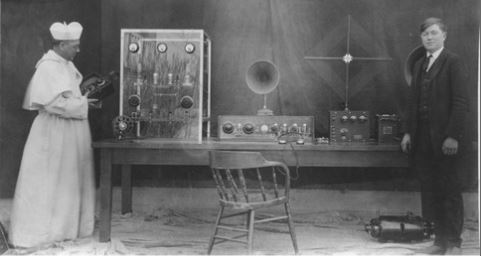
By Kris Leonhardt
Editor-in-chief
Continued from previous week
The 1920s saw continued growth in student body and programs, while their facilities remained at the same footprint as the college struggled to garner funding to make wanted changes.
One of the programs developed at this time took on a life of its own.
“So, WBAY actually started at St. Norbert College with an interest in crystal radios. This was around 1922,” explained Ted Miller, WBAY web manager/digital director and station historian.
“Radio was just becoming a thing, and apparently some students in the physics club and their teacher, one of the priests at St. Norbert, they were interested, they wanted to figure out how to make a radio.
“And they had an engineering student. It sounds like he was an adult, like a continuing education student we call them now because he had experience in engineering already and he was going back to St. Norbert for education – Cletus Collom.”
Collom came to St. Norbert College from Michigan.
He was older than other students in his class, due to dropping out of school following his father’s death to help his mother support five other children.
“Cletus developed his interest in electricity as a young boy. His interest was stimulated even more after he read a book on the life of Thomas Edison, a book which Cletus inherited from his father,” stated material from the 1959 St. Norbert College Alma Mater Award program.
“His quest for more knowledge led him to study batteries, wires, doorbells and anything that was operated by electricity. In the meantime, Cletus also had an opportunity to work in radio which helped him develop his talents more fully.
“In 1921, he built his own amateur radio set and began broadcasting…”
Collom was able to return to his education at St. Norbert College, where he used his talents to kick start a radio station, but funding was an issue, with just $50 given to the physics club for the project from the president.
“So, they built an amateur radio, using money donated by parents, collected by the students. And one of the priests ran a candy shop at the college. So, he provided like $500 in profits from the candy shop,” Miller further explained.
The entire cost of the station was just $600 at the time, with a 100-watt transmitter.
“With the arrival of the (FCC) license and the equipment, the engineering staff of WHBY went to work day and night to ready the equipment and the studio for broadcasting. The staff consisted of: Mr. George Carey, Frater James A. Wagner and Father Ignatius Van Dyke, assisting the chief engineer, Cletus Collom,” a De Pere Journal-Democrat article stated.
A transmitter was set up on the fourth floor of Boyle Hall on the St. Norbert College and the first test of the equipment was held on March 25, 1925, as announcer, George Carey, stated, ”This is the St. Norbert College Station, WHBY, in West De Pere, Wisconsin.”
After weeks of testing, on April 6, 1925, the station went on air.
“The college authorities are desirous of having the public feel that they want to represent the public at large in the make-up of the programs,” said college rector, Rev. M.J. Millay, in a Green Bay Press-Gazette article. “Suggestions will be gladly considered, as we hope to make the programs interesting to the larger number possible.”
In early 1928, the radio station moved to the Green Bay Columbus Club building, putting a studio on the second floor of the building, operating remotely from the college’s power station.
Late in that decade, the college turned back to growing its facilities.
The college marked Armistice Day in 1929 with a ground-breaking ceremony for a new gymnasium — which was the first of several buildings planned for the campus
“Armistice Day is the finest day in the year to start the building of a gymnasium. The men who went overseas did so to fight for the things they thought would allow their country to survive…,” Dr. A.M. Keefe stated in a speech that day.
Continued in next week’s edition
